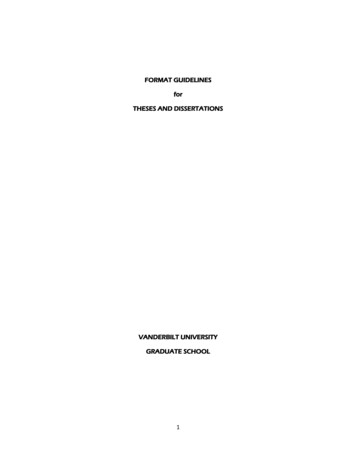
Transcription
FORMAT GUIDELINESforTHESES AND DISSERTATIONSVANDERBILT UNIVERSITYGRADUATE SCHOOL1
TABLE OF CONTENTS FOR GUIDELINESPageINTRODUCTION . 4Style. 4Composition and Structure . 4Acknowledgement of Support . 4MANUSCRIPT PREPARATION . 5Abstract . 5Title Pages . 5Font . 5Margins . 5Pagination . 5Spacing . 6Number Schemes . 6Division . 6Body of Manuscript . 6Words and Sentences. 6Headings and Subheadings . 6Acronyms/Abbreviations/Capitalization. 6Tables and Figures . 7Table of Contents Preparation . 7GENERAL INFORMATION. 7Language Other Than English . 7Multi-Part and Journal Article Format . 7Permission to Use Copyrighted Material . 8EXTRA COPIES . 8INTENT TO GRADUATE . 8FORMAT REVIEW. 8SUBMISSION . 8Master’s Thesis. 9Ph.D. Dissertation . 9ProQuest Information and Learning . 9Copyright Registration. 9Survey of Earned Doctorates . 9Curriculum Vitae . 9PRINTED SUBMISSION . 92
CHECKLIST for GRADUATION. 10INSTRUCTIONAL AND SAMPLE PAGESMargin Template . 11Format for Abstract . 12Sample Abstract . 13Format for Title Page . 14Sample Title Page. 15Sample Title Page, Revised for Electronic Submission . 16Sample Copyright Page . 17Sample Dedication Page . 18Sample Acknowledgement Page . 19Table of Contents Template . 20Sample Table of Contents . 21Sample List of Tables . 22Sample List of Figures . 23Spacing Template (Chapter One, Page 1) . 24Sample Chapter One, Page 1 . 25Sample Continuation Page (with quotation and footnotes) . 26Sample Continuation Page (with figure or table) . 27Sample References Page . 28ACADEMIC PROGRAMS AND MAJORS . 293
INTRODUCTIONThese guidelines provide students at Vanderbilt University with essential information abouthow to prepare and submit theses and dissertations in a format acceptable to the Graduate School.The topics range from writing style to the completion of required forms and the payment of fees.The majority of students submit an electronic version of their thesis or dissertation to theGraduate School. Electronic versions, once approved for format by the Graduate School, areuploaded to the Vanderbilt University database of Electronic Theses and Dissertations (ETD).There are instructions on the Graduate School website for guidance through this process.StyleThere is a distinct difference between submitting a manuscript to a publisher and providing acompleted thesis or dissertation to the Graduate School. A manuscript represents a pre-publicationformat; a thesis or dissertation is a final, completely edited, published document. Students shoulduse these guidelines, not other style manuals, as the final authority on issues of format and style.Areas not covered in this document or deviation from any of the specifications should be discussedwith a Graduate School format editor. Do not use previously accepted theses and dissertations asdefinite models for style.Composition and StructureManuscripts consist of four major sections and should be placed in the order listed:Preliminary PagesTitle Page (required)Copyright (optional, Ph.D. only)Dedication (optional)Acknowledgment (optional)Preface (optional)Table of Contents (required)List of Tables (required)List of Figures (required)List of Abbreviations/Nomenclature/Symbols (optional)TextIntroduction (may be referred to as Chapter 1)Body of ManuscriptReferences (required)Appendices (optional)Acknowledgement of SupportAcknowledgement of grant and contract support is included on the Acknowledgement page(Example: A grant from the National Science Foundation). A sample is on page 19.4
MANUSCRIPT PREPARATIONAbstractThe abstract is a separate document from the manuscript; it is not bound with the thesis ordissertation. Abstracts must be printed on white, 8 ½ x 11 inch paper. No page numbers areprinted on the abstract. One copy is required. Abstracts must have the original signature(s) of thefaculty advisor(s). The maximum length of the thesis abstract is 250 words. The maximum length ofthe dissertation abstract is 350 words, including the dissertation title. A sample is provided on page13. Majors are listed on page 29-30.Title PagesTitle pages must be printed on white, 8 ½ x 11 inch paper. Committee member signatures onthe title page must be originals.Spacing between text on the title page will vary according to the length of the title. Sampletitle pages, including one revised for electronic submission, are on pages 15-16. Formatinstructions are on page 14.FontUse a standard font consistently throughout the manuscript. Font size should be 10 to 12point for all text, including titles and headings. It is permissible to change point size in tables,figures, captions, footnotes, and appendix material. Retain the same font, where possible. Whencharts, graphs, or spreadsheets are “imported,” it is permissible to use alternate fonts.Italics are appropriate for book and journal titles, foreign terms, and scientific terminology.Boldface may be used within the text for emphasis and/or for headings and subheadings. Use bothin moderation.MarginsMeasure the top margin from the edge of the page to the top of the first line of text. Measurethe bottom page margin from the bottom of the last line of text to the bottom edge of the page.Page margins should be a minimum of one-half inch from top, bottom, left and right.Right margins may be justified or ragged, depending upon departmental requirements orstudent preference.PaginationThe title page is considered to be page one, but the page number should not be printed onthis page. All other pages should have a page number centered at the bottom of the page. Numberthe preliminary pages in lowercase Roman numerals. Arabic numerals begin on the first page oftext. Pages are numbered consecutively throughout the remainder of the manuscript.The Introduction may be placed before the first page of Chapter 1, if it is not considered achapter. The use of Arabic numbers may begin on the first page of the Introduction.5
SpacingThe entire text should be single-spaced, one and one-half spaced, or double-spaced. Blockquotations, footnotes, endnotes, table and figure captions, titles longer than one line, andindividual reference entries may be single-spaced.Double spacing should follow chapter numbers, chapter titles and major section titles(Dedication, Acknowledgements, Table of Contents, List of Tables, List of Figures, List ofAbbreviations, Appendices, and References). Double spacing should also occur before each firstlevel and second-level heading, and before and after tables and figures embedded in the text.There should only be one blank space after headings.Numbering SchemesChapters may be identified with uppercase Roman numerals or Arabic numbers. Tables,figures, and equations should be numbered consecutively throughout the manuscript with Arabicnumerals. Equation numbers should be placed to the right of the equation and contained withinparentheses or brackets.Use uppercase letters to designate appendices.DivisionBody of ManuscriptDepartments will determine acceptable standards for organizing master’s theses intochapters, sections, or parts. Usually, if a thesis has headings, a Table of Contents should beincluded.The dissertation must be divided into chapters. The use of parts, in addition to chapters, isacceptable.Words and SentencesTake care to divide words correctly. Do not divide words from one page to the next. Wordprocessing software provides for “widow and orphan” protection. Utilize this feature to help in theproper division of sentences from one page to another. In general, a single line of text should notbe left at the bottom or top of a page. Blank space may be left at the bottom of a page, wherenecessary.Headings and SubheadingsUse headings and subheadings to describe briefly the material in the section that follows. Beconsistent with your choice of “levels” and refer to the instructions on spacing, above, for properspacing between headings, subheadings, and text. First-level headings must be listed in the Tableof Contents. Second-level and subsequent subheadings may be eviations on the title page should appear as they do in the body of the thesis ordissertation. Examples: Xenopus laevis, Ca, Mg, Pb, Zn; TGF-β, p53.Capitalize only the first letter of words of importance, distinction, or emphasis in titles andheadings. Do not alter the all-cap style used for acronyms (Example: AIDS) and organizational6
names (Example: IBM). Use the conventional style for Latin words (Examples: in vitro, in vivo, insitu). Genus and species should be italicized. Capitalize the first letter of the Genus, but not that ofthe Species name (Example: Streptococcus aureus).Tables and FiguresFigures commonly refer to photographs, images, maps, charts, graphs, and drawings. Tablesgenerally list tabulated numerical data. These items should appear as close as possible to their firstmention in the text. Tables and figures may be placed in appendices, if this is a departmentalrequirement or standard in the field.Tables and figures should be numbered with Arabic numerals, either consecutively or bychapter. Be consistent in the style used in the placement of tables and figure captions.Tables and figures may be embedded within the text or placed on a page alone. When placedon its own page, a figure or table may be centered on the page. When included with text, a tableor figure should be set apart from the text.Tables and figures, including captions, may be oriented in landscape.Table data and figure data must be kept together, if the information fits on one page.Table of Contents PreparationAlthough the Graduate School does not provide word processing expertise or information,one hint is included. In Word, use the “Format Tabs” feature to prepare the table of contents. Typethe number 6.5 in the Tab stop position box, select Alignment right and select Leader Option 2.These commands allow the computer to right align the page numbers and accurately place the"dots". Use the space bar for indentation. Table of contents instructions and examples are includedon pages 20- 21.Use these same steps to prepare the List of Tables and Lists of Figures.GENERAL INFORMATIONLanguage Other than EnglishStudents in foreign language departments may submit manuscripts in a language other thanEnglish. The title of the thesis or dissertation should be written in the foreign language on the titlepage and abstract.Multi-Part and Journal Article FormatA multi-part presentation format may be used for combining research that has beenconducted in two or more related or non-related areas, or for presentation of combined journalarticles (published or submitted for publication). Organization of the parts or articles into chaptersis recommended. Each “chapter” may contain its own list of references and appendices.Each dissertation should include the appropriate preliminary pages, an introductionpresenting the general theme of the research and literature review, and a conclusion summarizingand integrating the major findings. Each “chapter” should consist of well-defined “subheadings,”such as introduction, methods, results, and discussion.7
The preliminary pages should include only one Table of Contents, List of Tables, List ofFigures, and List of Abbreviations/Nomenclature. Tables and figures should be placed within thetext, not at the end as is customary in articles prepared for journal publication.Permission to Use Copyrighted MaterialThe standard provisions of copyright laws regarding quoted material under copyright apply toelectronic publication. Dissertations are scanned by ProQuest for previously copyrighted material.When a student has published portions of their dissertation as articles in a copyrighted journal,permission from the journal to include that material must be obtained. ProQuest requires writtenpermission from the copyright holder of any extensively quoted material. Emailed approvals fromthe journals are accepted. Proper acknowledgement within the text of the manuscript must bemade. Students should discuss questions about copyrighted material with their dissertationdirector.EXTRA COPIESThe Graduate School recommends Campus Copy for procuring bound copies of theses anddissertations. You may contact them directly at 615-322-6849, or by email athttp://printingservices.vanderbilt.edu.INTENT TO GRADUATEAt the beginning of the semester in which a student will be completing a degree, he or shemust fill out an “Intent to Graduate” form and return it by the date specified at the top of the form.Intent forms can be downloaded at http://www.vanderbilt.edu/gradschool/form locator andrequire the signature of the Director of Graduate Studies. Inform the Graduate School ifinformation on “Intent to Graduate” form changes or if completion plans are delayed.FORMAT REVIEWAfter the specifications in these Guidelines have been incorporated into the thesis ordissertation, a student needs format approval. Please contact Liz Leis at liz.leis@vanderbilt.edu or322-3934 or Linda Harris at linda.harris@vanderbilt.edu or 322-3943 to schedule an appointment.This meeting requires less than an hour. It is helpful to send your document in advance, as an emailattachment.Students who no longer reside in Nashville must adhere to the specifications in theseGuidelines. Many students schedule a meeting time when they are on campus for their defense.Manuscripts can be sent for format review electronically. Students are responsible for ensuring thatall documents are received. The Graduate School address is 411 Kirkland Hall, VanderbiltUniversity, 2101 West End Avenue, Nashville, TN 37240.SUBMISSIONRequired documents should be submitted to the Graduate School by the deadline listed at thetop of the “Intent to Graduate” form. Refer to the “Checklist” on page 10.8
Master’sThesisThe master’s student must submit one copy of the title page, with original signatures of thecommittee members and one copy of the abstract, with the original signature of the advisor.Ph.D. DissertationThe doctoral student must submit one copy of the title page with original signatures of thecommittee members and one copy of the abstract, with the original signature of the advisor. Theforms described below must also be completed and returned.ProQuest Information and Learning. Dissertations must be published electronically throughProQuest. Please select the appropriate Publishing Agreement Form below:ProQuest Dissertation Electronic Submission Agreement orProQuest Dissertation Paper Submission AgreementReturn pages 4-5 (and possibly page 6) to the Graduate School.Worldwide access is preferred; however, students may restrict access to their work for a periodof up to two years. After two years, the dissertation will be released for worldwide access.Copyright Registration. ProQuest will register a copyright on behalf of doctoral recipients.Students who elect this service should sign the copyright section of the Publishing AgreementForm, include a copyright page within the dissertation, and pay the registration fee. Copyrighting isoptional. Discuss questions with committee members.Survey of Earned Doctorates. Students finishing a doctorate degree are requested to completethe SED survey accessible at https://sed-ncses.org. Information provided to the National OpinionResearch Council remains confidential and will be used for research or statistical purposes. Emailconfirmation of completed survey to GradSEDsubmission@vanderbilt.edu.Curriculum Vitae. Instructions on preparing a curriculum vitae are available at:http://vanderbilt.edu/gradschool/form locator/thesis and dissertation submission/CV requirement.pdf. This document should be sent electronically to Gradcvsubmission@vanderbilt.edu.PRINTED SUBMISSIONStudents who elect to print their theses or dissertation must provide the Graduate School withtwo complete copies of their document. Both copies must be printed on white, acid-free 8 ½ X 11inch paper of at least 20-lb. weight and 25% cotton content. Paper of this quality is required topreserve the content over time. Vanderbilt watermark meets these minimum specifications, butwatermark is not required.Copies submitted to the Graduate School must be sharp, clear, and free of smudges orextraneous marks. Text print must be consistently clear and in black ink. Print on one side of thepage only. The use of color in graphics, figures and tables enhances detail and is encouraged.There is a binding fee of 38 ( 19 per volume). Both copies are placed in the VanderbiltUniversity library system.9
Checklist for GraduationThe following items must be submitted to the Graduate School by the deadline listed on the Intent to Graduate form:Master’s Thesis:1.One copy of the title page on plain, white, 8½ X 11 inch paper (copy paper is acceptable) with original signaturesof advisor and second reader (month on the title page is the degree conferral—May, August, or December).2.One copy of the abstract on plain, white 8½ X 11 inch paper (copy paper is acceptable) with original signature ofadvisor(s).3. One copy of the “Completion of Master’s Thesis” form with original signatures of two faculty members and DGSPh.D. Dissertation:1.One copy of the title page on plain, white, 8½ X 11 inch paper (copy paper is acceptable) with the originalsignatures of committee members (month on the title page is the degree conferral month—May, August, orDecember).2.One copy of the abstract on plain, white, 8½ X 11 inch paper (copy paper is acceptable) with originalsignature of dissertation director.3.One photocopy of the signed title page on plain, white copy paper.4.ProQuest Publishing Agreement. Select appropriate link to access the document:ProQuest Dissertation Electronic Submission AgreementProQuest Dissertation Paper Submission AgreementComplete pages 4 & 5 only include page 6 if you elect to register your copyright.5.Survey of Earned Doctorates https://sed-ncses.org (email confirmation of completed survey toGradSEDsubmission@vanderbilt.edu).6.Curriculum vitae (send electronically to GradCVsubmission@vanderbilt.edu).7.Fees for electronic submission: 25.00 Traditional Publishing OR 120.00 Open Access Publishing 55.00 Copyright fee (optional)Fees for printed submission: 65.00 Traditional Publishing OR 160.00 Open Access Publishing 55.00 Copyright fee (optional)Select one option for submission of thesis or dissertation:Electronic submission: Revise title page with typed names of committee members, then convert document to aPDF. Name your file with your last name (for instance, Schemmer.pdf). Upload on the ETD (Electronic Thesesand Dissertations) website. There are no binding fees.ORPrinted submission: Two copies of the entire thesis or dissertation, printed on 8½ X 11 inch, white, quality bondpaper of at least 20-lb. weight and 25% cotton content, must be turned into the Graduate School. Both copies willbe placed in the Vanderbilt University library system. The binding fee is 38.00. Electronic publishing is alsorequired for printed dissertations.*Cash/checks: One check for total amount due made payable to Vanderbilt University; cash in exactamount only.10
Margin Template Minimum ½” top margin(from top of page to top of fist line text) Minimum ½” left marginMinimum ½” right margin (Page numbers fall WITHIN the bottom margin and must be centered(From the bottom of the last line of text to the bottom of the page)Minimum ½” bottom margin 11
Format for AbstractMAJOR(All caps, underlined, right justified,one inch from top of page. DO NOTprecede Program name with thewords “Department of”). *See pages29-30 for the list of majors(Set line spacing to double spacing after Title)Final title of dissertation, upper/lower case, single-spaced, centeredYour name, upper/lower case, centeredDissertation (or Thesis) under the direction of Professor (Full Name)(Underlined, centered, upper/lower case, double space to text, no page numbers)TEXT(Double spaced)ApprovedType full name of Dissertation (or Thesis) director12Date
Sample AbstractHUMAN GENETICSStrain-Specific Alleles of Phox2B DifferentiallyModify Sox10Dom AganglionosisLauren Colleen WaltersDissertation under the direction of Professor E. Michelle Southard-SmithHirschsprung disease (HSCR) is characterized by a lack of enteric ganglia in a variableportion of the distal bowel. The complex inheritance pattern of this disorder has led researchersto focus on genetic effects other than the putative disease mutation. Mouse models provide acontrolled background for these types of studies. Sox10 is an essential gene for the developmentof the enteric nervous system (ENS). Sox10Dom mice on a mixed genetic background exhibit thevariable aganglionosis seen in HSCR cases. Congenic lines of Sox10Dom mice on distinct inbredgenetic backgrounds, C57BL/6J (B6) and C3HeB/FeJ (C3Fe), differ in penetrance and extent ofaganglionosis. A linkage screen for modifiers of Sox10Dom aganglionosis was undertaken in alarge B6 X C3Fe F2 population. Several potential modifier regions were identified, with the mostsignificant located on chromosome five (Sox10m3). The most relevant candidate gene in thisregion was Phox2B, an essential factor in autonomic neurogenesis.Approved DateE. Michelle Southard-Smith, Ph.D.13
Format for Title PageTitle of dissertation, upper/lower case, single-spaced, centered(One inch from top of page to top of title)(Spacing will vary depending on length of the title of thesis or dissertation)ByYour Name(The following five lines must be included in this exact format)Dissertation (or Thesis)Submitted to the Faculty of theGraduate School of Vanderbilt Universityin partial fulfillment of the requirementsfor the degree ofDOCTOR OF PHILOSOPHYinMajor(Refer to pages 29-30)Month, Year*IMPORTANT: The month will always be either May, August, or DecemberThis is your actual GRADUATION semester, not your thesis or defense semesterNashville, TennesseeApproved: (Original signatures of committee members)Date:(Typed member’s full name under each signature line)(Typed member’s full name under each signature line)(Typed member’s full name under each signature line)(Typed member’s full name under each signature line)(Typed member’s full name under each signature line)(Title Page carries the value of page “i”, but do not print number on page)14
Sample Title PageMechanisms of Antibiotic Resistanceand Pathogenesis in Acinetobacter baumanniiByMarguerite Indriati HoodDissertationSubmitted to the Faculty of theGraduate School of Vanderbilt Universityin partial fulfillment of the requirementsfor the degree ofDOCTOR OF PHILOSOPHYinMicrobiology and ImmunologyAugust, 2012Nashville, TennesseeApproved:Date:Timothy L. Cover, M.D.Dean W. Ballard, Ph.D.Timothy S. Blackwell, M.D.Terence S. Dermody, M.D.Eric P. Skaar, Ph.D.(Title Page carries the value of page “i”, but do not print number on the page)15
Sample Title Pa
format; a thesis or dissertation is a final, completely edited, published document. Students should use these guidelines, not other style manuals, as the final authority on issues of format and style. Areas not covered in this document or deviation from any of the specifications should be discuss




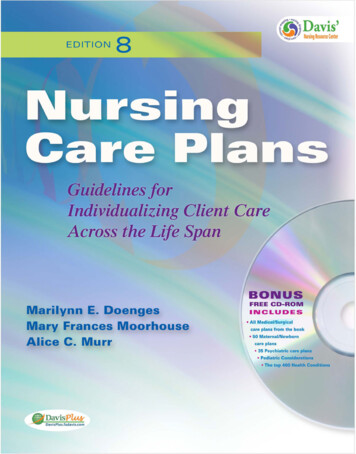
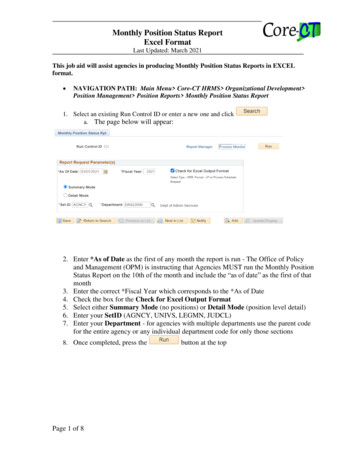
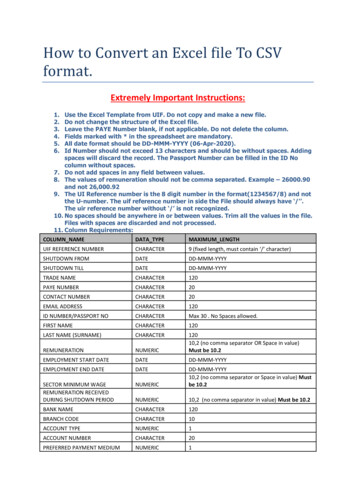
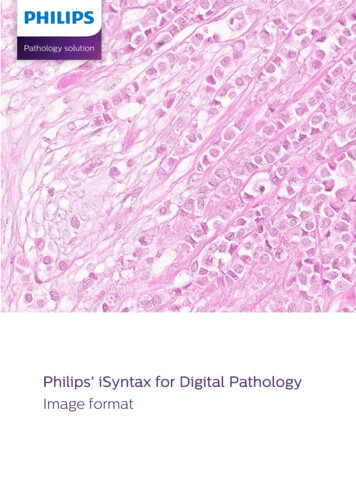
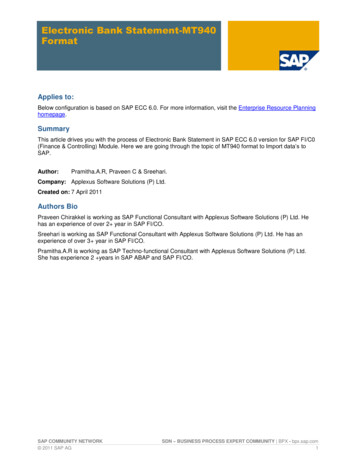
![[MS-OFFMACRO]: Office Macro-Enabled File Format](/img/3/5bms-offmacro-5d-130211.jpg)

